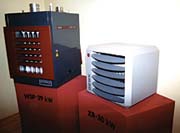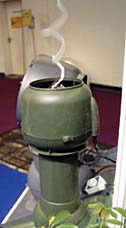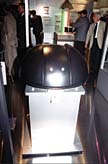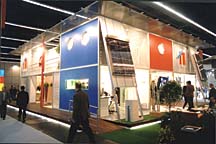
“Our industry has been hit by a reduction in new building activity,” Viessmann said, noting that there has also been a slowdown in renovation work. But he said this could change and noted that change could start at ISH.
The 2003 ISH show is a “good barometer” of mood. On the show floor, “We have met with a lot of activity,” Viessmann said. “Hopefully, ISH will turn around the negative trend and create an interest that might revitalize our industry.”
ISH is a major show covering engineering, installation, and building technology in such areas as HVACR and plumbing. Some 2,300 exhibitors showed wares for close to 200,000 people over five days. The first four days were for those within the industries represented. The final day was an “open house” of sorts, when anyone could walk the floor and view the products for about a $20 entrance fee.
The air conditioning and ventilation sector was given its own name, “Aircontec.” More than 200 companies in that sector occupied two of the 23 halls used for the overall expo.
Here is a sampling of technologies that may be of interest to stateside contractors interested in different approaches to creating comfort.

What’s The Word
If there was one theme at Aircontec, it was “cost cutting be damned.” Products promised high efficiencies, environmental correctness, and even designs aimed to make mechanical equipment pleasing to the eye. In fact, more than a few booth personnel bemoaned the “lowest price wins” approach to much of the installation work in the United States.One technology high on the attention-grabbing list was the “POPcool” air-handling unit developed by Paul Wurth of Luxembourg and shown at the booth of Munters of Germany (www.munters.de). Designed to supply dried and cooled air to a building, it combines a dehumidifying rotor and heat exchanger with additional water vaporization to cool the air. Outside air is heated slightly when it passes through the fan section. The fan pushes the air through a desiccant rotor, where it is dehumidified to a preset moisture content.
As dehumidification causes an increase in temperature, the air is heated up and the rotor dries the air down. The dry, warm air goes to an energy recovery section; dry cooling takes place in a plate heat exchanger. The temperature difference between the return air from the building and the dried air is used to cool the dried space.
The developer stated that the technology means cold water distribution pipes don’t need insulation, the power of the cooling system can be reduced by 75 percent, and energy consumption is reduced as much as 50 percent compared to systems where the air drying is achieved by cooling.

More Energy Recovery
Manufacturers have long tried to deliver on the concept of “free cooling.” At ISH, one proponent was Weiss Technik of Germany (www.wut.com). “Existing free-cooling technology dictates that 30 kW of cooling can be achieved in a unit 2.5-m wide,” the company said. “But the Weiss Tele 90.C3 can deliver between 50 and 60 kW with a unit less than 2-m wide.”The company uses what it calls “a special intelligent damper configuration” to operate in 100 percent free cooling, mixed air, or DX modes. In the summer it is pretty much a DX system. In spring and fall, it is possible to use the mixed mode.
In such cases, “when the outside air temperature is below the set value of the room temperature, the unit operates with 100 percent fresh air, which is routed over the evaporator with the discharge air cooling the condenser. The fresh air is cooled to the required supply air temperature in six stages,” said the company.
During winter, “with the outside temperature below the set value of the room temperature, the unit operates with 100 percent free cooling. If the minimum humidity value is not reached in mixed operation, the unit switches to circulating-air operation with mechanical cooling.”
Energy recovery was also on the mind of IV Produkt of Sweden (www.ivprodukt.com), whose booth officials said its latest technology was being supplied to the United States through McQuay. The Energy Recovery Unit RXA uses a rotary heat exchanger to transfer energy and moisture. The rotor inside the heat recovery unit consists of alternate flat and corrugated strips of aluminum foil. This forms passages through which the air flows in a laminar pattern. The manufacturer said this ensures low pressure drop and little risk of dust or other impurities collecting on the rotor surface.
According to the company, “Moisture can be recovered from the extract air whenever the outdoor air temperature is low. If high demands are made on moisture transfer, the heat exchanger can be equipped with a hygroscopic rotor.”
A regenerative-type heat ex-changer was the focus at the booth of Ecorotor of Germany (e-mail buero.cronjaeger@mrb.de). The product line includes a model with oxidized aluminum heat transfer media for sensible and limited latent recovery, and a model with a hygroscopic coating for total energy enthalpy recovery. There was also a model designed for sensible heat transfer with latent recovery only when operating below the dewpoint of the exhaust air, and a model with the addition of a baked-on epoxy coating to provide corrosion resistance.

Ventilation
One goal among the ventilation sector was achieving the desired objective while using as little energy as possible. The British company Vent-Axia (www.vent-axia.com) maintained that it has come up with a commercial fan “with twice the motor life and using up to 80 percent less energy than equivalent competitor products.” Two new products (part of its LoWatt T-Series) are the Turbo, an in-line duct fan for industrial applications, and a very basic Stimpac with DC technology, as well as the ability to connect to AC.Another example of fan technology came from the Slovina company Hidria Corp. (www.rotomatika.si), which had an aluminum sheet blade on a fan said to maintain low noise and good aerodynamics.
Rooftop fans and exhaust pipes from the Finnish company Sk Tuote Oy (www.sktuote.fi) are fabricated with polypropylene.
In the “looks mean a lot” category, Gebhardt Ventilation of Germany (www.gebhardt.de) showed its Ergovent rooftop units with motor. The design has a cowl-like appearance.
Design consideration was noted by Sabiana of Italy (www.sabiana.it), which said its latest fancoil has “aesthetics of continuous and rounded curves such as (have) never been designed before.”
The Italian company Ma.Ti.Ka (www.matikasrl.it) promised to be a virtual one-stop shop when it comes to wheels and blades producing centrifugal wheels, forward-curved blades, radial and helical blades, and welded and spot-welded wheels.
The Air Comfort Control (ACC) company from Innosource of the Netherlands (www.innosource.nl) offered what was billed as “balanced and controlled ventilation systems.” The units are said to control the decentralized air supply as well as the center exhaust unit. New software keeps the system “in balance,” so that exhaust and supply air “is the same, which prevents pressure differences and draft.”
The Ukrainian company Vents (www.ventilation-system.com) has ventilators and accessories “characterized by a high quality level, a modern design, and availability to a wide sector of consumers.”
And there was Trocellen of Germany (www.trocellen.com), which used “cross-linked polyolefin foams” for insulation.

Smaller And Cleaner
Most manufacturers want to make the next generation of a product smaller and better. That was the tack taken by the Danish company Winter Warm (www.winterwarm.com). Its industrial space heater, the XR-30, is said to be three times as small as its predecessor.“This is possible,” said booth officials, “because the heat exchanger has a patented design and is manufactured from high-grade materials.”
Two temperature sensors, one on top and one in the working zone, measure the temperature gradation continuously. When the temperature reaches a certain level, the fan on the heater will remain switched on, “utilizing the unit as a destratification fan.”
If the room temperature gets too low, the burner will switch on automatically. A modulating burner generates the amount of heat required.
Acofis (www.acofis.de), a German company, noted that in many air conditioning systems, air flowing through the system is humidified and cleaned by humidifiers. But, the company argued, “During this process, dust and microorganisms are transferred from the air into the circulating water and collect there.”
To counter this problem, Acofis offers a disinfection process. “If the air humidifier is already dirty, the biofilm in the whole system is removed by surge treatment with chlorine dioxide.”
The company also offers a variation of the process as a preventive approach. In such cases, “The clean plant is filled with fresh water; then the circulating water is fed with the necessary amount of chlorine dioxide permanently and according to the requirement of the plant.”
Metal And Fabric
If you want a metal ceiling in a building, Gesellschaft f?r Ingenieurprojekte Freiburg, GIF for short (www.gif-web.de), offered an aluminum option, into which could be mounted the air conditioning ductwork, “guaranteeing the draft-free introduction of supply air.” The company suggested that a prime application could be commercial kitchens.A number of companies at the show did away with any kind of metal when it came to ductwork. One solution was polyester ductwork from Prihoda of the Czech Republic (www.prihoda.cz). The company’s Textile Air Distribution System was promoted as operating “without drafts even in cooling, having high hygiene given by the possibility of washing with disinfectant, very low weight, and quick assembly.”
Here the emphasis on aesthetics of many European companies was evident. “It is possible to use [textile air distribution systems] for a sophisticated interior; a demanding customer can be satisfied with correct choice of material, its fitted finish, suitable shape of the diffuser, and the way of installation as well as color finish.”
Oraven (www.oraven.com) of Germany also highlighted the appearance of its products. “We understand design not only as an aesthetic task, but above all as a technical necessity,” the company said.
“Our systems use the entire textile surface of the duct as a blow-out unit; for the displacement ventilation as a diffuse flow with an exit speed under 0.2 meters per second, or as induction ventilation with a high pulse for the controlled circulation of room air.”
DEC International of the Netherlands (www.decinternational.com) was on the same tack, offering flexible and semi-flexible ducts for low-, medium-, and high-pressure air conditioning applications, as well as exhaust, ventilation, and heating systems.
Joining a long list of flex-vent companies was Sodiamex of France (e-mail sodiamex@sodiamex.com), which showed PVC-free flexible duct composed of a polyethylene mesh coat.
What’s In A Name
Some of the bigger names in HVAC, such as Carrier, York International, Mitsubishi Electric, and Airwell, came to the ISH show as part of a single large booth called, “Marketplatz Raumklimagerate.”Such companies were so well known that their presence was more maintenance of image than the rolling out of a lot of new products, so they opted for the marketplace approach offered by ISH. Each of the dozen or so companies had large logos in the booth area and representatives on hand to greet customers and answer questions.

Sidebar: This House Is Smart
FRANKFURT, Germany — The focal point at the most recent ISH show here was the SmartHouse, which bore an uncanny resemblance to the home of George Jetson of cartoon fame, but had an array of new technologies — including a toilet that rises and lowers, and is flushed from hand controls extending out from bars.Developed by the Fraunhof Institute of Microelectronic Circuitry & Systems with the backing of some 12 manufacturers, SmartHouse “is equipped with innovative and intelligent systems networked for communication,” according to its developers.
“For example, it will be possible to check and operate the heating system from any Internet-connected PC or mobile phone,” they said. “Technical faults, leaking pipes, etc., can be reported to the occupant or authorized technician and rectified before damage occurs.”
The bathroom and workout rooms can be programmed according to individual preferences or controlled remotely with a mobile phone, according to the developers. “Upon entering the bathroom, the washbasin and toilet rise or lower to a height or disability — either by hand or through a voice control system.”
Key to the project is use of a PC or laptop that will “increasingly become the main tool of heating, plumbing, and air conditioning.” While such technology is already widely used to link to industry Web sites, “SmartHouse now shows the next step: Service companies can now continuously monitor their customers’ priorities without having to be on site.”
One aspect of that was remote access to heating system data through Vitocom interfaces developed by German company Viessmann. “Plant operators or service companies can communicate with heating systems, in order to operate or monitor it or even change system parameters during remote servicing. Any irregularities will be automatically and directly transferred to a mobile phone or fax via the Internet.”
Additional HVAC applications include information on when ventilation system filters need replacing, when worn-out reactive anodes of the hot water boiler need to be replaced, and even guaranteeing the correct quality of drinking water.
— Peter Powell
Publication date: 05/05/2003


Report Abusive Comment